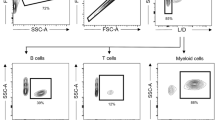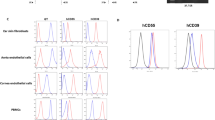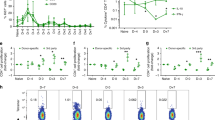Abstract
Induction of tolerance to transplantation carbohydrate antigens is of clinical significance in recipients of ABO-incompatible allografts, or of xenografts. The experimental animal model used for studying such tolerance was that of α1,3galactosyltransferase (α1,3GT) knockout (KO) mice, which lacks the α-gal epitope (Galα1-3Galβ1-4GlcNAc-R) and which can produce the anti-Gal antibody against it. In contrast, wild-type (WT) mice synthesize the α-gal epitope and are immunotolerant to it. KO lymphocytes transduced in vitro with adenovirus containing the α1,3GT gene (AdαGT) express α-gal epitopes. Administration of such lymphocytes into KO mice resulted in tolerization of naïve and memory anti-Gal B cells. Mice tolerized by AdαGT transduced lymphocytes failed to produce anti-Gal following immunizations with pig kidney membranes (PKM) expressing multiple α-gal epitopes. This tolerance was perpetuated by transplanted syngeneic WT mouse hearts expressing α-gal epitopes. Transplanted WT hearts survived in the tolerized KO mice for at least 100 days, despite repeated PKM immunizations. Control mice receiving lymphocytes transduced with adenovirus lacking the α1,3GT gene were not tolerized, but produced anti-Gal and rejected transplanted WT hearts. This study suggests that autologous lymphocytes transduced with adenovirus containing A or B transferase genes may induce a similar tolerance to blood group antigens in humans.
This is a preview of subscription content, access via your institution
Access options
Subscribe to this journal
Receive 12 print issues and online access
$259.00 per year
only $21.58 per issue
Buy this article
- Purchase on Springer Link
- Instant access to full article PDF
Prices may be subject to local taxes which are calculated during checkout







Similar content being viewed by others
References
Thall AD, Maly P, Lowe JB . Oocyte Galα1-3Gal epitopes implicated in sperm adhesion to the zona pellucida glycoprotein ZP3 are not required for fertilization in the mouse. J Biol Chem 1995; 270: 21437–21442.
Yang Y-G et al. Tolerization of anti-Galα1-3Gal natural antibody-forming B cells by induction of mixed chimerism. J Exp Med 1998; 187: 1335–1342.
Ohdan H et al. Mixed chimerism induced without lethal conditioning prevents T cell- and anti-Galα1,3Gal-mediated graft rejection. J Clin Invest 1999; 104: 281–290.
Bracy JL, Sachs DH, Iacomini J . Inhibition of xenoreactive natural antibody production by retroviral gene therapy. Science 1998; 281: 1845–1847.
Bracy JL, Iacomini J . Induction of B-cell tolerance by retroviral gene therapy. Blood 2000; 96: 3008–3015.
Ogawa H, Yin D-P, Shen J, Galili U . Tolerance induction to a mammalian blood group like carbohydrate antigen by syngeneic lymphocytes expressing the antigen. Blood 2003; 101: 2318–2320.
Mohiuddin MM, Ogawa H, Yin D-P, Galili U . Tolerance induction to a mammalian blood group like carbohydrate antigen by syngeneic lymphocytes expressing the antigen. II. Tolerance induction on memory B cells. Blood 2003; 102: 229–236.
Galili U et al. Evolutionary relationship between the natural anti-Gal antibody and the Galα1-3Gal epitope in primates. Proc Natl Acad Sci USA 1987; 84: 1369–1373.
Galili U et al. Man, apes, and Old World monkeys differ from other mammals in the expression of α-galactosyl epitopes on nucleated cells. J Biol Chem 1988; 263: 17755–17762.
Galili U, Rachmilewitz EA, Peleg A, Flechner I . A unique natural human IgG antibody with anti-α-galactosyl specificity. J Exp Med 1984; 160: 1519–1531.
Galili U, Macher BA, Buehler J, Shohet SB . Human natural anti-α-galactosyl IgG. II. The specific recognition of α(1-3)-linked galactose residues. J Exp Med 1985; 162: 573–582.
Galili U, Buehler J, Shohet SB, Macher BA . The human natural anti-Gal IgG. III. The subtlety of immune tolerance in man as demonstrated by crossreactivity between natural anti-Gal and anti-B antibodies. J Exp Med 1987; 165: 693–704.
Galili U . Interaction of the natural anti-Gal antibody with α-galactosyl epitopes: a major obstacle for xenotransplantation in humans. Immunol Today 1993; 14: 480–482.
Good AH et al. Identification of carbohydrate structures which bind human anti-porcine antibodies: implications for discordant xenografting in humans. Transplant Proc 1992; 24: 559–562.
Sandrin MS, Vaughan HA, Dabkowski PL, McKenzie IF . Anti-pig IgM antibodies in human serum react predominantly with Galα1-3Gal epitopes. Proc Natl Acad Sci USA 1993; 90: 11391–11395.
Collins BH et al. Cardiac xenografts between primate species provide evidence for the importance of the α-galactosyl determinant in hyperacute rejection. J Immunol 1995; 154: 5500–5510.
Larsen RD et al. Isolation of a cDNA encoding a murine UDPgalactose:β-D-galactosyl-1,4-N-acetyl-D-glucosaminide α-1,3-galactosyltransferase: expression cloning by gene transfer. Proc Natl Acad Sci USA 1989; 86: 8227–8231.
Joziasse DH et al. Bovine α1-3-galactosyltransferase: isolation and characterization of a cDNA clone. Identification of homologous sequences in human genomic DNA. J Biol Chem 1989; 264: 14290–14297.
Tanemura M et al. Elimination of anti-Gal B cells by α-gal ricin. Transplantation 2002; 73: 1859–1868.
Tearle RG et al. The α-1,3-galactosyltransferase knockout mouse. Implications for xenotransplantation. Transplantation 1996; 61: 13–19.
LaTemple DC, Galili U . Adult and neonatal anti-Gal response in knock-out mice for α-1,3galactosyltransferase. Xenotransplantation 1998; 5: 191–196.
Tanemura M, Yin D, Chong AS, Galili U . Differential immune responses to α-gal epitopes on xenografts and allografts: implications for accommodation in xenotransplantation. J Clin Invest 2000; 105: 301–310.
Deriy L, Chen Z-C, Gao G-P, Galili U . Expression of α-Gal epitopes on HeLa cells transduced with adenovirus containing α1,3galactosyltransferase cDNA. Glycobiology 2002; 12: 135–144.
Wood C, Kabat EA, Murphy LA, Goldstein IJ . Immunochemical studies of the combining sites of the two isolectins, A4 and B4, isolated from Bandeiraea simplicifolia. Arch Biochem Biophys 1979; 198: 1–11.
Gao GP, Yang Y, Wilson JM . Biology of adenovirus vectors with E1 and E4 deletions for liver-directed gene therapy. J Virol 1996; 70: 8934–8943.
Galili U et al. One percent of human circulating B lymphocytes are capable of producing the natural anti-Gal antibody. Blood 1993; 82: 2485–2493.
Galili U et al. Interaction between human natural anti-α-galactosyl immunoglobulin G and bacteria of the human flora. Infect Immun 1988; 56: 1730–1737.
Springer GF, Horton RE . Blood group isoantibody stimulation in man by feeding blood group-active bacteria. J Clin Invest 1969; 48: 1280–1291.
Galili U . Evolution and pathophysiology of the human natural anti-Gal antibody. Springer Semin Immunopathol 1993; 15: 155–171.
Lin SS et al. The role of anti-Galα1-3Gal antibodies in acute vascular rejection and accommodation of xenografts. Transplantation 2000; 70: 1667–1674.
Watts A et al. Plasma perfusion by apheresis through a Gal immunoaffinity column successfully depletes anti-Gal antibody: experience with 320 aphereses in baboons. Xenotransplantation 2000; 7: 181–185.
Mohiuddin MM et al. Antibody-mediated accommodation of heart grafts expressing an incompatible carbohydrate antigen. Transplantation 2003; 75: 258–262.
Goodnow CC et al. Altered immunoglobulin expression and functional silencing of self-reactive B lymphocytes in transgenic mice. Nature 1988; 334: 676–682.
Goodnow CC, Brink R, Adams E . Breakdown of self-tolerance in anergic B lymphocytes. Nature 1991; 352: 532–536.
Nemazee DA, Burki K . Clonal deletion of B lymphocytes in a transgenic mouse bearing anti-MHC class I antibody genes. Nature 1989; 337: 562–566.
Sakaguchi S et al. Immunologic tolerance maintained by CD25+ CD4+ regulatory T cells: their common role in controlling autoimmunity, tumor immunity, and transplantation tolerance. Immunol Rev 2001; 182: 18–32.
Shevach EM . CD4+ CD25+ suppressor T cells: more questions than answers. Nat Rev Immunol 2002; 2: 389–400.
Radic MZ, Erikson J, Litwin S, Weigert M . B lymphocytes may escape tolerance by revising their antigen receptors. J Exp Med 1993; 177: 1165–1173.
Tiegs SL, Russell DM, Nemazee D . Receptor editing in self-reactive bone marrow B cells. J Exp Med 1993; 177: 1009–1020.
Chirmule N et al. Immune responses to adenovirus and adeno-associated virus in humans. Gene Therapy 1999; 6: 1574–1583.
Galili U . The two antibody specificities within human anti-blood group B antibodies. Transfus Med Rev 1988; 2: 112–121.
Galili U, Ishida H, Tanabe K, Toma H . Anti-Gal A/B, a novel anti-blood group antibody identified in recipients of ABO incompatible kidney allografts. Transplantation 2002; 74: 1574–1580.
Starzl TE et al. Renal homografts in patients with major donor recipient blood group incompatibilities. Surgery 1964; 55: 195–200.
Wilbrandt R et al. ABO blood group incompatibility in human renal homotransplantation. Am J Clin Pathol 1969; 51: 15–23.
Rydberg L . ABO-incompatibility in solid organ transplantation. Transfus Med 2001; 11: 325–342.
Cooper DKC . Clinical survey of heart transplantation between ABO blood group-incompatible recipients and donors. J Heart Transplant 1990; 9: 376–381.
Yamamoto F et al. Molecular genetic basis of the histo-blood group ABO system. Nature 1990; 345: 229–233.
Acknowledgements
This study was supported by NIH Grant AI45849 and by a grant from the American Heart Association.
Author information
Authors and Affiliations
Rights and permissions
About this article
Cite this article
Ogawa, H., Yin, DP. & Galili, U. Induction of immune tolerance to a transplantation carbohydrate antigen by gene therapy with autologous lymphocytes transduced with adenovirus containing the corresponding glycosyltransferase gene. Gene Ther 11, 292–301 (2004). https://doi.org/10.1038/sj.gt.3302178
Received:
Accepted:
Published:
Issue Date:
DOI: https://doi.org/10.1038/sj.gt.3302178
Keywords
This article is cited by
-
Gene therapy to inhibit xenoantibody production using lentiviral vectors in non-human primates
Gene Therapy (2007)
-
In vivo targeting of vaccinating tumor cells to antigen-presenting cells by a gene therapy method with adenovirus containing the α1,3galactosyltransferase gene
Cancer Gene Therapy (2005)



